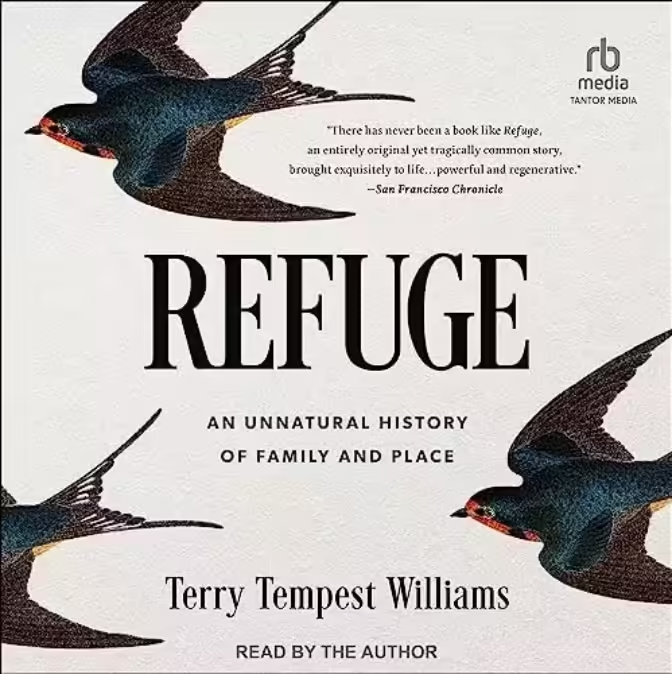Refuge: Thoughts on Denial and Ecology by Terry Williams
Interconnection Between Family and Environment
Terry Williams’ “Refuge” masterfully weaves together not just two separate stories; she forges an unbreakable link between two main threads.
This isn’t just a book; it’s a wake-up call that demands our attention.
Refuge is a book that shows Terry’s mother’s battle with cancer and the environmental upheaval threatening the Great Salt Lake and Bear River Migratory Bird Refuge.
Williams forces us to confront this connection, shattering the illusion that we exist separate from our environment.
Think about it:
When was the last time you saw your own family’s struggles reflected in the natural world around you?
As her mother’s health wanes, the waters of the Great Salt Lake rise, flooding the refuge.
“The flooding helped me to face the losses within my family,”
This line highlights how environmental changes mirror personal grief and loss
The message in Refuge is clear:
Williams challenges us to see beyond our personal bubbles and recognize the connection between our wellbeing and that of our surroundings.
In my eyes, this connection is a call to action.
Here’s why.
If the health of our loved ones is intrinsically tied to the health of our environment, how can we continue to ignore ecological crises?
Williams’ narrative demands that we rethink our priorities and our place in the natural world.
She asks us:
- Can we heal ourselves without healing our planet?
- Are we truly able to understand our own stories without understanding the story of the land we inhabit?
This isn’t just about Williams’ mother or the Bear River Migratory Bird Refuge.
It’s about you, your family, and the place you call home.
It’s about recognizing that every environmental shift, every ecological threat, has deeply personal consequences.
And Refuge is her way to offer ‘refuge’ for us and the planet together.
The Main Concepts of Refuge
“I am not adjusting. I keep dreaming the Refuge back to what I have known,”
Nature follows its own course, indifferent to human designs.
The rising lake becomes an embodiment of nature’s resistance to being subdued, a reminder that control is often an illusion.
Williams’ depiction of this futile battle speaks to the arrogance we have.
This arrogant belief that the world’s ecosystems can be neatly contained or manipulated according to our desires.
This critique is a commentary on the broader human impulse to impose order on a world that thrives in chaos.
In trying to control nature, we are trying to impose certainty and predictability on forces that are fundamentally dynamic and ever-changing.
Williams emphasizes that the natural world is not something to be “managed” into stability.
Rather, it is a living, breathing entity that resists such artificial constraints.
It shifts and alters according to its own rhythms, not those dictated by human hands.
While we can alter its course, it’s not often that lasting and comes with a consequence.
This struggle between control and autonomy also speaks to the discomfort we feel in the face of uncertainty.
We are conditioned to seek stability, to believe that with enough effort and technology, we can maintain control.
Control over our environments, our futures, and even our destinies.
But Williams throws an interesting idea here about this note.
She argues that this desire for control is rooted in fear – fear of the unknown, fear of change, fear of losing what we have built.
The rising waters force a confrontation with the reality that no matter how advanced our systems and technologies become, nature retains the final say.
It is a humbling recognition that, for all our ingenuity, there are forces far beyond our grasp.
Yet, Williams does not merely lament humanity’s failed attempts at control; she calls for a shift in perspective too.
A type of change that embraces coexistence over domination.
This requires a fundamental change in how we approach our relationship with the environment.
In this acceptance lies a path to deeper resilience, one that does not hinge on maintaining a fragile balance of control but on adaptation.
In the end, the main point behind the rising Lake is this:
Can we find lasting emotional stability if our environment is in constant upheaval?

The Comfort of Denial
Denial is one of the most insidious defenses our minds employs.
It skillfully keeps us in the dark about truths we are not yet ready, or willing, to confront.
And you guessed it, it leads to self-injury and crisis when reality inevitably catches up on us.
In *Refuge*, Terry Williams captures this duality.
She illustrates how denial, while seemingly protective, is also profoundly destructive:
“Denial protects us from the potency of a truth we cannot yet bear to accept.”
This insight goes beyond mere observation.
It lays bare the ways in which denial not only cushions us from discomfort but actively works against our growth.
At its core, denial flourishes in the familiar.
It wraps us in the comforts of what we already know, leading us to believe that change is unnecessary or, worse, impossible.
In this space, we cling to what we have always done and who we have always been.
This ultimately builds walls that keep us insulated from the unsettling prospect of transformation.
Williams’s Refuge suggests that this is precisely where denial is most dangerous even when the truth is urging us toward something new.
The seduction is in its simplicity:
denial tells us that if we stay where we are and resist the push of uncomfortable truths, we can avoid the pain of upheaval.
But as Williams poignantly notes, “Denial lies.”
It makes us think that the world outside those boundaries becomes a threat, something to be avoided.
Yet I think denial has another bad side to it where it isn’t just about resisting external change.
The side I mainly reference here is the doubting of our internal capacity for transformation.
Williams touches on the deep fear that change will break us, that we are not strong enough to endure the dismantling of our current selves.
This construction is a defense mechanism, shielding us from the vulnerability that comes with stepping into the unknown.
The irony is that in seeking comfort, we end up reinforcing the very conditions that cause our discontent.
The real challenge lies in trusting that the world will hold us, even if we fall apart in the process of change.
Williams invites us to think that the walls denial constructs are also barriers to the growth that can only come from embracing uncertainty and discomfort.
And to dismantle those walls, courage is required and a willingness to face truths that are potent and, at times, painful.
In the end, Williams’ reflection on denial is a call to confront our own illusions.
It is a challenge to move beyond the mind’s acrobatics and into a place of honesty, where we can face the truths we have long resisted.
And in doing so, we find the strength to change—even if it means falling apart in the process.
The Role of Storytelling as Activism
Williams’ narrative is a blend of memoir, family history, and environmental reflection.
Each thread reinforces the others.
By sharing intimate stories of her mother’s battle with cancer and the legacy of her family’s ties to the land, she delivered on one key point.
Williams situates environmental degradation within a personal context that is relatable and compelling.
This deeply personal lens invites us readers to see environmental issues not as distant abstract concerns but as matters that are tied to our survival.
She writes:
“Storytelling is the oldest form of education,”
This reminds us that stories have always been how we make sense of the world.
In business, the best products have the best stories, not the best stats or functionalities.
The same applies here.
When she connected personal struggles to larger ecological crises, she illustrated that the health of the land and our families are inseparable.
But as you might notice in her book, Williams’ storytelling is not confined to the personal.
It extends into the political realm, where she critiques policies and decisions that have harmed both people and the environment.
In discussing the legacy of nuclear testing in the American West, for example, she draws a direct line between governmental negligence and the suffering of her family members.
All of whom have cancers that are linked to exposure from fallout.
Here, the personal becomes political, and Williams uses her story to highlight systemic injustices.
This blend of the personal and political is where storytelling becomes a potent tool for activism.
It humanizes the consequences of policies and brings our attention to environmental and social issues in ways that data alone cannot.
Her love for the places she grew up in is not conveyed through scientific or environmental jargon.
It is through stories that evoke the sensory and spiritual experience of being in nature.
In doing so, Williams bridges the gap between human and non-human worlds, showing that our stories are intertwined with the stories of the land itself.
This approach to storytelling as environmental advocacy is particularly effective because it does not rely on fear or guilt to spur action.
Instead, it invites us to feel a sense of belonging to the natural world and have a connection that naturally leads to care and stewardship.
Her stories are a call to remember our place within the web of life.
She urges us to protect what we love by first recognizing that we are inextricably linked to the earth’s fate.
Also, she encourages us to tell our own stories.
To recognize that it is through these narratives that we can build communities of care and action and become the agent of change.



